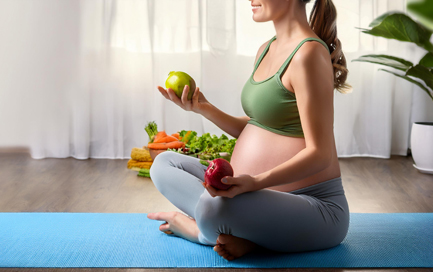Pregnancy is a beautiful and transformative phase in a woman’s life. During this time, a woman undergoes significant physiological and psychological changes as she transitions from being an individual to becoming a mother. While this period is filled with excitement and joy, it can also bring about some anxiety. The physical changes in the body and the concern about how to meet the needs of the baby may be overwhelming for many expectant mothers.
This article aims to provide first-time mothers with essential insights into maternity, covering topics such as calculation of gestational age, diet, exercises and precautions.
Gestational Age: How is Pregnancy Calculated?
A woman’s menstrual cycle is typically considered to be 28 days, with ovulation occurring around day 14. However, this can vary among individuals. Fertilization typically happens 12-14 hours after ovulation. The sperm can survive in the female reproductive system for up to 5 days, which means fertilization can still occur if intercourse happens a few days before ovulation. An average pregnancy lasts about 280 days (40 weeks). This is generally calculated from the first day of the woman’s last menstrual period (LMP), even though conception usually occurs about two weeks after the LMP. If pregnancy is calculated based on conception, it would be 266 days. However, calculating gestational age using LMP is the standard method. Therefore, it’s crucial for a woman to inform her obstetrician or gynecologist about her menstrual history, such as the duration of her cycles and flow. This information helps the doctor estimate the length of her cycles, determine ovulation, and provide an accurate estimated due date (EDD).
In addition to calculating based on LMP, highly trained professionals can also estimate the EDD by examining the uterine size during a pelvic exam. Ultrasound is considered the most accurate method if the LMP is unknown or if the woman has irregular cycles. A transvaginal (TV) ultrasound is typically used to detect intrauterine pregnancy (IUP) after about 4 weeks of LMP, as an embryo is usually visible between 5-6 weeks.1 Accurate calculation of gestational age is essential for providing optimal care for both the mother and baby. It helps determine the timing of important tests and screenings, reducing the risk of complications for both the mother and fetus.
Pregnancy is divided into three trimesters:
- First Trimester (Weeks 1-12): During this time, your body undergoes various changes, including hormonal shifts to support the growing fetus. Common symptoms during this trimester may include fatigue, mood swings, tender and swollen breasts, food cravings or aversions, constipation, headaches, and heartburn. Major organs like the heart, brain, and spinal cord begin to develop in the fetus. The fetal heartbeat can typically be detected around 5-6 weeks, which is a sign of a developing pregnancy.
- Second Trimester (Weeks 13-28): Symptoms from the first trimester often subside during this time. As the baby grows, you may notice a baby bump. Toward the end of the second trimester, you may feel the baby’s movements. This period also brings visible changes, such as stretch marks, a dark line running from your belly button to the pubic hairline, and skin darkening in some areas. Travel is generally considered safe during this trimester, but it’s always a good idea to consult your doctor to ensure there are no health concerns.
- Third Trimester (Weeks 29-40): As the baby grows, it may put pressure on your organs, leading to discomforts such as breathing difficulties, frequent urination, and heartburn. These discomforts may be similar to those in the second trimester. You may also experience contractions, which could be false labor or the real thing.2 It’s important to be prepared for labor and delivery, so packing a maternity bag and being ready for the birth is essential.
Recommended Supplements During Pregnancy
To support maternal health and fetal development, healthcare providers may prescribe specific supplements. The timing and dosage of these supplements can vary depending on individual health conditions. Taking these supplements is essential to reduce the risk of maternal and fetal complications.
1. Iron and Folic Acid Supplements:
Folic acid is typically prescribed from the beginning of the first trimester, while iron is recommended after the first trimester unless the mother is anemic, in which case it may be started earlier. During pregnancy, the body’s demand for iron increases 2 to 3 times, and for folate, it increases 10 to 20 times. This is due to the need for hemoglobin synthesis and the production of specific enzymes for both the mother and the fetus.3 Inadequate intake can lead to anemia, making the body more vulnerable to infections. The World Health Organization (WHO) recommends a daily intake of 30 mg to 60 mg of elemental iron and 400 µg (0.4 mg) of folic acid during pregnancy. These supplements help prevent maternal anemia, low birth weight, preterm birth, and puerperal sepsis.4
2. Calcium Supplements:
In populations with low dietary calcium intake, daily supplementation of 1.5 g to 2.0 g of elemental calcium is recommended. Calcium helps maintain the mother’s bone density and reduces the risk of pre-eclampsia (high blood pressure during pregnancy), which can lead to preterm birth.4 It may also alleviate leg cramps and is vital for the baby’s bone development.
3. Vitamin A:
Vitamin A supplementation is advised only in areas where deficiency is a severe public health concern. It is mainly recommended to prevent night blindness in pregnant women.
Supplements Not Recommended During Pregnancy: According to WHO guidelines, certain supplements are not recommended to improve maternal and perinatal outcomes. These include vitamin D, E, and C supplements as well as some multiple micronutrient supplements which you can obtain through your balanced diet4. Also, don’t take any supplements unless prescribed by your doctor.
Food Recommendations During Pregnancy
Maintaining a healthy diet during pregnancy is essential to ensure that both the mother and baby receive adequate energy, proteins, vitamins, and minerals.
a. Foods to Eat:
A well-balanced diet consisting of whole foods supports better nutrient absorption, provides fiber and offers a mix of nutrients. Here is the list of some recommended foods:
- Fruits: Include a variety of fresh, frozen, or dried fruits in your diet.5 Examples include bananas, apples, oranges, pears, berries (strawberries, blueberries, raspberries), grapes, watermelon, pomegranates, guava, chikoo, and plums. Ripened papaya and pineapple can be consumed in moderation, but excessive intake may lead to contractions.
- Vegetables and Pulses: Consume raw, canned, frozen, or dried vegetables5. Focus on the intake of more green leafy vegetables like spinach and kale. Other good options include carrots, onions, beets, leeks, turnips, cabbage, lettuce, broccoli, tomatoes, bell peppers, sweet potatoes, pumpkins, and regular potatoes.6Pulses are rich in vitamins B and C, minerals, fiber, and proteins. Include black-eyed beans, fenugreek, mung beans, lentils, chickpeas, kidney beans, soybeans, and peas in your meals.
- Whole Grains: Whole grains are excellent sources of energy, vitamins, minerals, and fiber. Incorporate brown rice, whole wheat (bread, flour, pasta, tortillas), barley, millets (such as bajra and ragi), and corn into your diet.
- Milk and Dairy Products: Dairy products are essential for calcium intake, supporting the development of your baby’s bones and teeth.6 Include milk, yogurt, cheese, butter, and ghee. For those who are lactose intolerant or vegan, fortified plant-based milk like soy milk, almond milk or oat milk are good alternatives. Always choose pasteurized products.
- Protein-Rich Foods: Proteins play a crucial role in your baby’s development and your body’s recovery. Include a variety of protein-rich foods such as eggs, chicken, fish, meat, lentils, beans, nuts, and seeds (almonds, walnuts, chia seeds, flaxseeds), peas, cottage cheese (paneer) and soybeans.
- Healthy Oils and Fats: Choose healthier fats found in avocados, nuts (almonds, cashews, peanuts, walnuts) and seeds (flaxseeds, chia seeds). Fatty fishes like salmon and sardines are also beneficial. Use plant-based oils such as olive oil, canola oil, flaxseed oil, avocado oil and coconut oil.
b. Foods to Avoid:
Certain foods can pose risks during pregnancy due to potential bacterial contamination, toxins, or harmful compounds. Here are the foods to avoid:
- Raw, unpasteurized milk and products made from unpasteurized milk (like soft cheeses) can contain harmful bacteria such as Listeria, which may cause listeriosis.
- Avoid consuming any food past its expiration date, as it may harbor bacteria.
- Raw or undercooked meat products may contain harmful parasites and bacteria.
- Avoid uncooked fish and seafood, as they may contain parasites and bacteria.
- Refrigerated smoked seafood such as smoked salmon, should be avoided unless it is thoroughly cooked.
- Certain fish varieties with high mercury content such as shark, swordfish, king mackerel, and tilefish should be avoided.
- Uncooked sprouted seeds, grains, and beans (often used in salads) may contain bacteria and should be avoided unless cooked.
- Raw or undercooked eggs and foods made from raw eggs, such as homemade mayonnaise, should be avoided.
- Avoid store-made salads such as chicken salad, egg salad and tuna salad, as they may harbor bacteria.
- Liver and other organ meats are rich in iron and vitamin A, but high levels of vitamin A can lead to toxicity and pose risks.(5,7)
- Herbs and plant-based medicines should only be taken with your doctor’s approval.
- Unripe or semi-ripe papaya should be avoided. It contains a latex-like substance called papain, which may trigger uterine contractions and cause some digestive issues.
- Avoid consuming large quantities of pineapple. An enzyme called bromelain in pineapple may soften the cervix and induce contractions.
Remember, supplements can only help to fill your nutritional gaps, they cannot replace a healthy diet. So, follow a healthy diet for a healthy pregnancy.
Hydration During Pregnancy
Staying properly hydrated is essential during pregnancy. It supports both maternal health and fetal development. While various beverages can contribute to your daily fluid intake, water remains the healthiest option as it contains no calories or additives. The European Food Safety Authority (EFSA) recommends that pregnant women should consume approximately 2.3 liters of fluids per day.8 However, exceeding this recommended amount significantly may lead to conditions like water intoxication and hyponatremia, which can disrupt the body’s electrolyte balance. Fluids can be consumed in many forms including water, fresh juices, milk, soups, coconut water and herbal teas. Maintaining proper hydration offers numerous benefits during pregnancy:
- Supports fetal circulation: Adequate fluid levels help maintain proper blood flow to the fetus.
- Aids in the production of amniotic fluid: Water is crucial for sustaining the right amount of amniotic fluid, which protects and cushions the baby.
- Facilitates nutrients and oxygen transport: Hydration ensures efficient delivery of essential nutrients and oxygen to the developing baby.
- Prevents urinary tract infections (UTIs): Drinking enough fluids helps flush out bacteria, reducing the risk of infections.
- Relieves constipation: Water helps soften stools and promotes regular bowel movements.
- Improves tolerance to blood loss during delivery: Staying hydrated can help maintain blood volume, which is beneficial during childbirth.
- Eliminates waste products: Proper hydration supports kidney function, aiding in the removal of waste from the body.
- Enhances nutrient absorption and digestion: Fluids assist in breaking down food and absorbing essential nutrients.
- Supports the absorption of water-soluble vitamins: Vitamins like B-complex and C require adequate water for proper absorption and utilization.9
Exercise During Pregnancy
Engaging in moderate physical activity during pregnancy is generally safe and beneficial. According to the American Pregnancy Association, pregnant individuals can aim for 30 minutes of exercise daily or about 20 minutes on 3 to 4 days each week.
a. Benefits of Exercise During Pregnancy:
- Boosts energy levels
- Enhances mood and posture
- Reduces common discomforts such as swelling, bloating, constipation, and back pain
- Promotes muscle tone, strength, and endurance
- Supports better sleep quality
- Lowers the risk of developing gestational diabetes and preeclampsia10
- Walking
- Swimming
- Prenatal yoga
- Gentle stretching
- Pelvic tilts
b. Exercises to Avoid During Pregnancy:
- Activities with a high risk of falling (e.g., skiing, cycling on rough terrain)
- Exercises that could lead to abdominal trauma
- Movements involving jumping, hopping, skipping, or bouncing
- Breathing techniques that require holding your breath for extended periods
- Movements that involve twisting at the waist
- Heavy weightlifting
- Exercising in overly hot or humid conditions
Always consult with a healthcare provider before starting any new exercise routine during pregnancy to ensure it aligns with your specific needs and health status.
Precautions During Pregnancy
- Attend all prenatal checkups and routine screenings on time to monitor fetal growth and your health condition.
- Do not take any medications, herbal remedies or other treatments without consulting your doctor first.
- If you have existing health conditions like diabetes, high blood pressure or thyroid issues, manage them with the help of your healthcare provider.
- Consider purchasing a blood pressure monitor and blood sugar testing devices for home use, if recommended by your doctor.
- If any concerning symptoms arise, consult your doctor immediately. For example, monitor for preeclampsia by using a blood pressure monitor and watch for symptoms like high blood pressure, swelling, headaches and changes in vision.
- Avoid alcohol and smoking, as these can harm your baby.
- Limit the intake of caffeinated beverages.
- Ensure you get 7-9 hours of sleep each night to maintain your health.
- Sleep on your left side to improve blood flow to your baby. You can use pillows for additional support to help you sleep more comfortably.
- From the second trimester onward, avoid sleeping on your back as the growing belly may place pressure on vital blood vessels.
- Stay away from strong chemicals such as pesticides, paints, cleaning products and solvents.
- Avoid overheating your body. Stay away from hot environments, hot tubs and saunas.
- Try not to stand for long periods.
- Avoid prolonged sitting or lying down, as it can impair blood circulation, increase the risk of blood clots, cause back pain, and lead to excessive weight gain.
- Sexual activity is generally safe but consult your doctor if you have high-risk conditions and need further guidance.
- Wear loose and breathable clothing, wire-free soft bras, and comfortable maternity pants or leggings.
- Avoid wearing high heels. Choose sandals, flats or sneakers instead.
- Pack your maternity bag 3-4 weeks before your due date. Be prepared in case your baby arrives early.
- Always seek advice from your doctor. Every pregnancy is unique, and experiences vary. Be cautious of advice from others and clarify any doubts with your healthcare provider.
References
- Edwards KI, Itzhak P. Estimated Date of Delivery. [Updated 2024 Sep 10]. In: StatPearls [Internet]. Treasure Island (FL): StatPearls Publishing; 2025 Jan-. Available from: https://www.ncbi.nlm.nih.gov/books/NBK536986/
- Office on women’s health. Stages of pregnancy. Office on women’s health. Published February 22, 2021.Acessed February 11, 2025. Available from: https://womenshealth.gov/pregnancy/youre-pregnant-now-what/stages-pregnancy
- Soma-Pillay P, Nelson-Piercy C, Tolppanen H, Mebazaa A. Physiological changes in pregnancy. Cardiovasc J Afr. 2016 Mar-Apr;27(2):89-94.
- World Health Organization. WHO recommendations on antenatal care for a positive pregnancy experience. WHO. 2016. Available from: 9789241549912-eng.pdf
- Unicef parenting. What to eat when pregnant: Tips for nourishing your growing baby. Unicef. Accessed February 12, 2025. Available from: What to eat when pregnant | UNICEF Parenting
- World Health Organization. Regional Office for Europe. (2001). Healthy eating during pregnancy and breastfeeding: booklet for mothers. Copenhagen: WHO Regional Office for Europe. Available from: https://iris.who.int/handle/10665/108425
- Office on women’s health. Staying healthy and safe. Office on women’s health. Published February 22, 2021.Acessed February 12, 2025. Available from: https://womenshealth.gov/pregnancy/youre-pregnant-now-what/staying-healthy-and-safe
- European Food Safety Authority (EFSA), Parma, Italy. Scientific Opinion on Dietary Reference Values for water1EFSA Panel on Dietetic Products, Nutrition, and Allergies (NDA). EFSA Journal. 2010; 8(3):1459
- Montgomery KS. Nutrition Column An Update on Water Needs during Pregnancy and Beyond. J Perinat Educ. 2002 Summer;11(3):40-42.
- American pregnancy association. Exercise During Pregnancy. Accessed February 12. 2025. Available from: https://americanpregnancy.org/healthy-pregnancy/is-it-safe/exercise-during-pregnancy/




